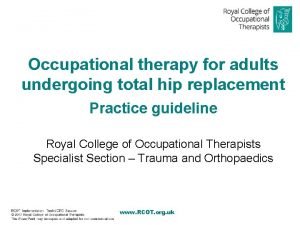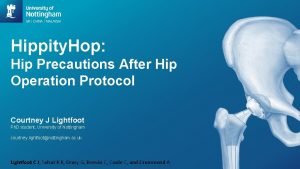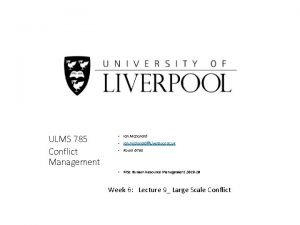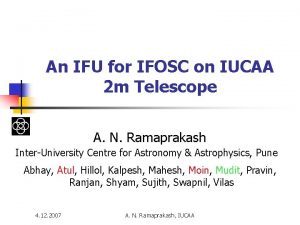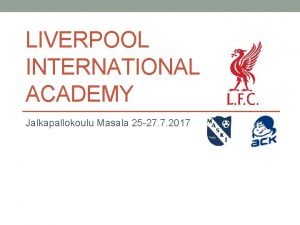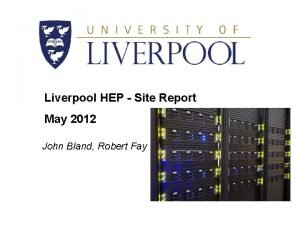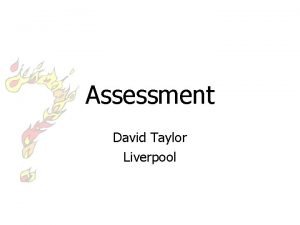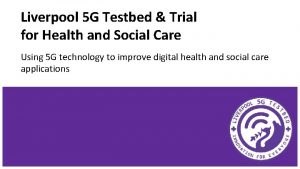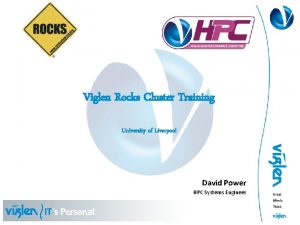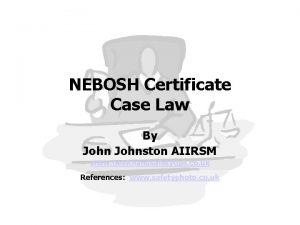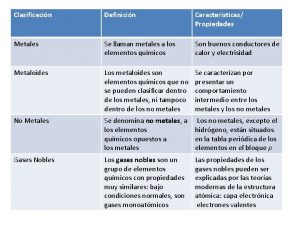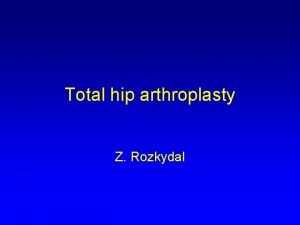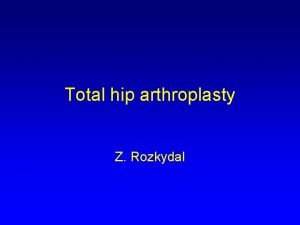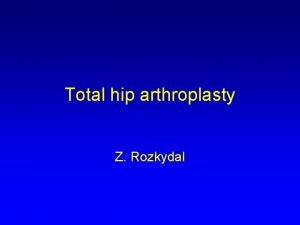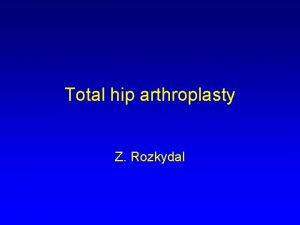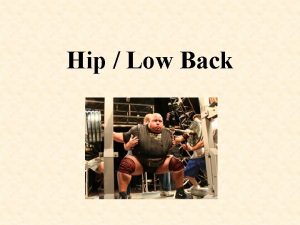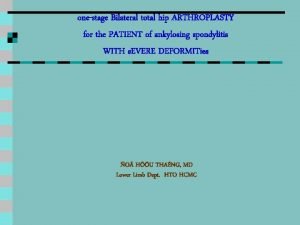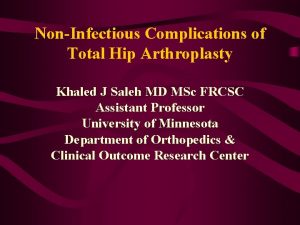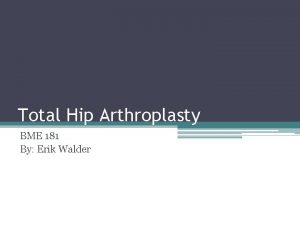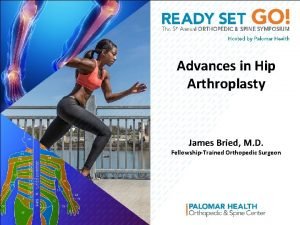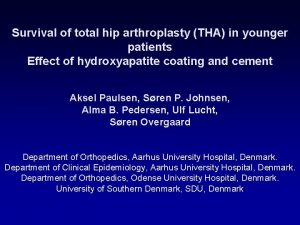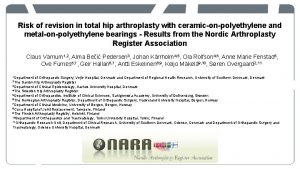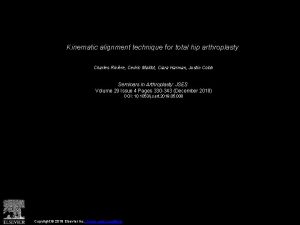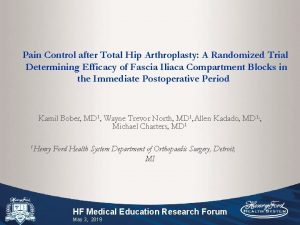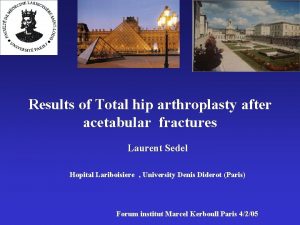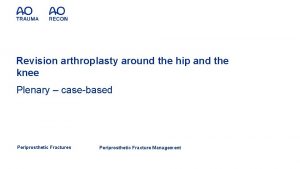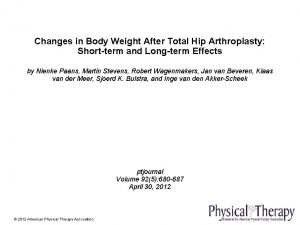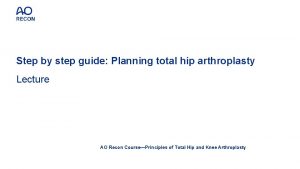Metal on Metal Hip Arthroplasty Experiences in Liverpool







































- Slides: 39

Metal on Metal Hip Arthroplasty Experiences in Liverpool Cathy Armstrong Research Physiotherapist Royal Liverpool University Hospitals Trust

Background �Orthopaedic Hip team consists of 3 consultant orthopaedic surgeons �Research Physiotherapist (Cathy Armstrong) �Specialist Registrar �Hip Fellow �I have been in post since 2002

History of Metal on Metal (M-o-M) Hips Royal Liverpool Hospitals � 1998 -2002 255 Birmingham Hip Resurfacings implanted � 2002 - change of surgeon. Due to reports of # NOF with BHR he used the Birmingham head on a Freeman Stem

History of Metal on Metal (M-o-M) Hips Royal Liverpool Hospitals �Birmingham cup and head on a Freeman uncemented stem (Birmingham Hybrid) � 2002 -2003 implanted n=203 �Due to change of manufacturer the Birmingham Hybrid was no longer implanted after 2003

Metal-on-Metal hip types � 2003 -2005 Variety of metal on metal implants used e. g. . Pinnacle cup and SROM stem Pinnacle cup and Corail stem � 215 implanted

Metal-on-Metal hips types � 2005 ASR hips implanted. Same surgeon who preferred long stems. � 121 implanted with either SROM or Corail Stems � 2002 -2010 Additional metal on metal used for revisions and smaller numbers of other types of hips

Metal-on-Metal hip types � 1998 -2010 Metal on Metal hip arthroplasties performed = 854

Research Physio Post �I’ve been in post since 2002. �Follow up clinically and radiologically. �Initially working alongside consultant in clinic. �As numbers and experience increased a separate follow up clinic was setup. �Competency was assured via masters module in xray interpretation

Problems arise with M-o-M THR’s �Approx. 2004/5 we started to notice increase in patients complaining of pain and “unhappy” with hip. �Most patients complained of Trochanteric pain and clicking in the groin.

Problems arise with M-o-M THR’s �This coincided with articles reporting complications, Jacobs et al 1998 & 2003, Hallab et al 2005, Park et al 2005. �Up until this point other sources of pain were investigated because x-rays and routine bloods were essentially normal. Many patients were investigated for spinal problems.

Problems arise with M-o-M THR’s � 2006 onwards we started looking at blood inflammatory markers. �Inconclusive results �Urine analysis for Chromium(Cr) and Cobalt(Co)started.

Levels of Metal ions in Urine �Literature suggests normal values between 2 and 6 nmol/L (Newton et al 2012) �Our cohort of patients showed the following levels of urine metal ions: �Median Cobalt= 334 (2 -10, 759) nmo. L/L �Median Chromium= 97. 3 (4 -2920) nmo. L/L �Urine testing may not be suitable as heavy metal ions are excreted too quickly to be found at significant levels. For this reason we stopped analysing this.

Photo of Trochanteric swelling with Metal-on-Metal THR �Swelling and fluid in the hips was described in the literature Pandit et al 2008. �The Term Pseudotumours was coined (Pandit et al 2008) �These are seen over the Trochanter and in the groin.

Intraoperative findings �Around this time surgeons were noticing large amount of fluid and necrotic tissue when revising hips.

Pseudotumour and necrosis.

Radiological Diagnosis �Started using U/S to look for “Pseudotumours” �Fluid around hip (i. e. in psoas bursa) only was analysed at first �Trochanteric fluid was thought to be bursitis only �Many early signs may have been missed due to inexperience looking at these hips. �Quality of tissues was not examined initially.

Ultrasound of fluid in the hip joint

Change of focus on Metal-on. Metal hips. � 2007 a protocol was developed by the Surgeon, Hip fellow and Research Physio at Royal Liverpool Hospitals as follows: �All M-o-M patients were followed up: � 2 yearly � X-rays � Clinical exam � Blood tests.

Change of focus on Metal-on. Metal hips. � 2008 BHS and BOA steering group, MHRA and NJR identified large diameter M-o-M articulations at risk. They suggested orthopaedic teams look at these more closely. � 2010 MHRA issued a medical devices alert (MDA) drawing attention to all Metal-on Metal hip replacements. �All metal-on-metal prostheses should be followed up annually until 5 years. �Our protocol was modified again to accommodate the yearly follow ups.

Modified protocol for M-o-M hips �Yearly follow up with: �Clinical Examination �X-ray �Blood tests �Imaging if blood tests were showing metal ions >7 ppb.

Blood Metal ion levels �Literature described analysis of metal ions in blood �Many debates on whether whole blood or serum is best to detect metal ions. �Newton et al 2012 suggests serum is better to detect chromium and whole blood to detect cobalt. �MHRA guidelines state whole blood threshold levels.

Metal ion levels Normal levels of metal ions: <40 nmol/L Chromium <20 nmol/L cobalt � Our cohort median blood metal ion levels: Chromium= 40. 3 nmol/L (3 -2470) Cobalt= 45. 9 nmol/L(12 -1304) � MHRA guidelines suggest anything over 7 ppb should be further investigated. � That translates to 120 nmol/L cobalt and 135 nmol/L Chromium � Confusion in measuring between ppb (parts per billion) and nmol/L (nanomoles per litre)from different labs.

Metal ion measurement �Initially all samples were analysed at the Trace Elements Laboratory in Birmingham as Royal Liverpool Hospitals had not been approved to analyse for Cobalt and Chromium. �Royal Liverpool University Hospitals Laboratory is now approved as a National Trace Elements Centre therefore these tests have been performed in house since 2011.

Metal ion measurement �Difficulty in taking the blood samples initially. �Theories that the metal needle may cause contamination led to a protocol to be developed where the first 10 mls were discarded.


Re-organisation of clinical followup �Yearly follow-up meant increased clinic appointments. �ASR specific clinics were set up and funded by the manufacturer. �A specific M-o-M follow-up clinic was developed. A business plan was developed my myself and the trust to provide this service. �We now receive referrals to follow up M-o-M hips which were performed in other areas and other countries.

2013 and onwards �Now BHR’s revised 14% ASR’s revised 55% Hybrids revised 20% Others revised 20%

2013 and onwards �Metal Artefact Reduction Series (MARS) MRI now used to detect fluid in the hip. �This is more accurate and can, when read by an experienced member of the radiology team, detect soft tissue degradation such as rupture of the gluteal tendon insertions. �Sometimes this is more evident than fluid alone. �Mars MRI is becoming more specialised in reducing the artefact and therefore more sensitive.

MARS MRI Showing disruption of the abductor tendons.

MARS MRI Showing fluid around the Greater Trochanter.

2013 and onward �Issues faced: �Patients need a lot of counselling and support. �Many are angry and confused at “being ignored” for many years. �Media coverage is making people more aware and in some cases is very frightening.

Terms used to describe these reactions. �Pseudotumours �ALVAL (Aseptic Lymphocytic Vasculitis and Associated Lesions) seen on histological analysis of tissue from revisions. �Metal hypersensitivity �These are now all under the umbrella of ARMD or Adverse Reactions to Metal Debris

How the service is changing �MHRA guidelines 2012 suggest we now follow up all M -o-M hips annually with X-ray and blood tests for the life of the prosthesis. �Due to increased screening more patients are being identified with increased metal ions and no symptoms. �They are dealt with on an individual basis.

How the service is changing �Litigation means that I am dealing with solicitors on a weekly basis and liaising between solicitors, the manufacturer and the NHS. �Providing proof of implants and outcomes to solicitors. �This is not a job that can be done by clerical staff as operation notes, implants and investigation outcomes need to be analysed.

How the service is changing �Clinical practicalities = more time to deal with the increased numbers of patients and their need for counselling. �Liaising with the consultants about arrangements for aspiration and revision. �Lifetime commitment for the lifetime of the prosthesis at present but this may change.

However the Prostheses are dressed up, all metal on metal hips need to be followed up. Thank You

Publications from our unit on M-o-M hips � Newton, A. W. , Ranganath, L. , Armstrong, C. , Peter, V. & Roberts, N. B. (2012) Journal Of Orthopaedic Research (Oct). 1640 -1646: Differential Distribution of Cobalt, Chromium, and Nickel between Whole Blood, Plasma and Urine in Patients after Metal-on-Metal (Mo. M) Hip Arthroplasty. � Metal ion levels decrease after revision for metallosis arising from large diameter metal on metal hip arthroplasty. D Ebreo, A Khan, M El -Meligy, C Armstrong, V Peter. Acta Orthopedica Belgica. 2011, 777 -781 � Correlation between inclination of the acetabular component and metal ion levels in metal on metal hip resurfacing / replacement. A Khan, D Ebreo, A Khan, M El-Meligy, C Armstrong, V Peter. J. Orthopaedics 2011; 8(1)e 16

References �Jacobs, JJ. Hallab, NJ. Skipor, AK & Urban RM (2003). Metal Degradation Products. A cause for concern in metal-metal bearings? Clinical Orthopaedics and Related Research 417, 139147. �Hallab, NJ. Anderson, S. Staffordd, T. Glant, T & Jacobs JJ (2005). Lymphocyte responses in patients with total hip arthroplasty. Journal of Orthopaedic Research 23; 384 -391. �Park, Y. Moon, Y. Lim S. Yang, J. Geunghwan, A & Choi Y (2005). Early Osteolysis following second generation metal-on-metal hip replacement. JBJS (Am) 87 -A: 1515 -1521. �Pandit, H. Glyn-Jones, S. Mc. Lardy-Smith, P. Gundle, R. Whitwell, D. Gibbons, CL. Ostlere, S. Athanasou, N. Gill, HS & Murray DW (2008). Pseudotumours associated with metal-onmetal hip resurfacings. JBJS (Br) 90 (7); 847 -51.

Bibliography � � � � Daniel J, Ziaee H, Pradhan C, Pynsent PB, Mc. Minn DJ. Blood and urine metal ion levels in young and active patients after Birmingham hip resurfacing arthroplasty: four-year results of a prospective longitudinal study. J Bone Joint Surg Br. 2007 Feb; 89(2): 169 -73 7. Daniel J, Ziaee H, Pradhan C, Mc. Minn DJ. Six-year results of a prospective study of metal ion levels in young patients with metal-on-metal hip resurfacings. J Bone Joint Surg Br. 2009 Feb; 91(2): 176 -9 Davies AP, Willert HG, Campbell PA, et al. An unusual lymphocytic perivascular infiltration in tissue around contemporary metal-on-metal joint replacements. J Bone Joint Surg Am. 2005; 87: 18– 27. Metal-on-metal hip replacement and hip resurfacing arthroplasty. What does the MHRA medical device alert mean? http: //www. jisrf. org/pdf_files/Mo. M_BOA-BHS_Adviceto. Surgeons_1. pdf Malviya A. et al. Metal-on-Metal Total Hip Arthroplasty. J. Bone Joint Surg. Am. 2010; 92: 1675 - 1683. Mac. Donald SJ. A consensus paper on metal ions in metal-on-metal hip arthroplasty. J. Arthroplasty. 2004; 19: Sppl. 3 12 -16. Kim PR. et al. Cobalt and chromium levels in blood and urine following hip resurfacing arthroplasty with the conserve plus implant. J. Bone Joint Surg. Am. , 2011; 93: 107 - 117. Haddad, FS. et al. Metal-on-metal bearings: The evidence so far. J Bone Joint Surg Br, 2011; 93 -B: 572 579. Shimmin AJ, Back D. Femoral neck fractures following Birmingham hip resurfacing: a national review of 50 cases. J Bone Joint Surg Br 2005; 87: 463 -4. Cross. Ref. Medline � � Finsbury Orthopaedics. ASR marketing and science. Bulletin No 58. 2006. Access link here. De Haan R, Pattyn C, Gill HS, Murray DW, Campbell PA, De Smet K. Correlation between inclination of the acetabular component and metal ion levels in metal-on-metal hip resurfacing replacement. J Bone Joint Surg Br 2008; 90: 1291 -7. Cross. Ref. Medline ↵ Langton DJ, Sprowson AP, Joyce TJ, Reed M, Carluke I, Partington P, et al. Blood metal ion concentrations after hip resurfacing arthroplasty: a comparative study of articular surface replacement and Birmingham Hip Resurfacing arthroplasties. J Bone Joint Surg Br 2009; 91: 1287 -95. Cross. Ref. Medline ↵ Morlock MM, Bishop N, Zustin J, Hahn M, Rüther W, Amling M. Modes of implant failure after hip resurfacing: morphological and wear analysis of 267 retrieval specimens. J Bone Joint Surg Am 2008; 90(suppl 3): 89 -95. Cross. Ref. Medline ↵ Lee RK, Essner A, Longaray J, Wang A. Metal-on-metal bearings: the problem is edge-loading wear. Surg Technol Int 2010; 20: 303 -8. Medline Langton DJ, Joyce TJ, Mangat N, Lord J, Van Orsouw M, Smet KD, et al. Reducing metal ion release following hip resurfacing arthroplasty. Orthop Clin North Am 2011; 42: 169 -80. Medline ↵ Mc. Minn Centre. Northern lights debate ASR vs BSR. Access link here. Lavigne M, Belzile EL, Roy A, Morin F, Amzica T, Vendittoli P-A. Comparison of whole-blood metal ion levels in four types of metal-on-metal large diameter femoral head total hip arthroplasty: the potential influence of the adapter sleeve. J Bone Joint Surg Am 2011; 93: 128 -36. � � � �
 Occupational therapy hip replacement interventions
Occupational therapy hip replacement interventions Hip hop hip to the hippity
Hip hop hip to the hippity Hip hop hip the hippity
Hip hop hip the hippity Arthroplasty practitioner
Arthroplasty practitioner Ian mcdonald liverpool
Ian mcdonald liverpool Sandfield park liverpool
Sandfield park liverpool Maurizio salaris
Maurizio salaris Archdiocese of liverpool
Archdiocese of liverpool Ifosc
Ifosc Amaze liverpool
Amaze liverpool Dr david taylor liverpool
Dr david taylor liverpool Liverpool
Liverpool Healthy homes liverpool
Healthy homes liverpool Liverpool leiri
Liverpool leiri Jean baptiste ebrard biografia
Jean baptiste ebrard biografia Liverpool hep c
Liverpool hep c Yot liverpool
Yot liverpool David taylor liverpool
David taylor liverpool Ingeus liverpool
Ingeus liverpool Ben johnson liverpool
Ben johnson liverpool Craig greenwood liverpool
Craig greenwood liverpool Common law
Common law Reid anderson liverpool
Reid anderson liverpool Ste jones liverpool
Ste jones liverpool Liverpool rebranding
Liverpool rebranding Aimes liverpool
Aimes liverpool The tannery liverpool
The tannery liverpool Archdiocese of liverpool education
Archdiocese of liverpool education Karen lewis liverpool
Karen lewis liverpool Ged fitzgerald liverpool
Ged fitzgerald liverpool Peter north liverpool
Peter north liverpool Olly drove 56 km from liverpool to manchester
Olly drove 56 km from liverpool to manchester University of liverpool csd
University of liverpool csd Gary millar liverpool
Gary millar liverpool David taylor liverpool
David taylor liverpool Cie liverpool
Cie liverpool David power liverpool
David power liverpool Jason parsons liverpool
Jason parsons liverpool Aiirsm
Aiirsm Propiedades del hidrogeno
Propiedades del hidrogeno
